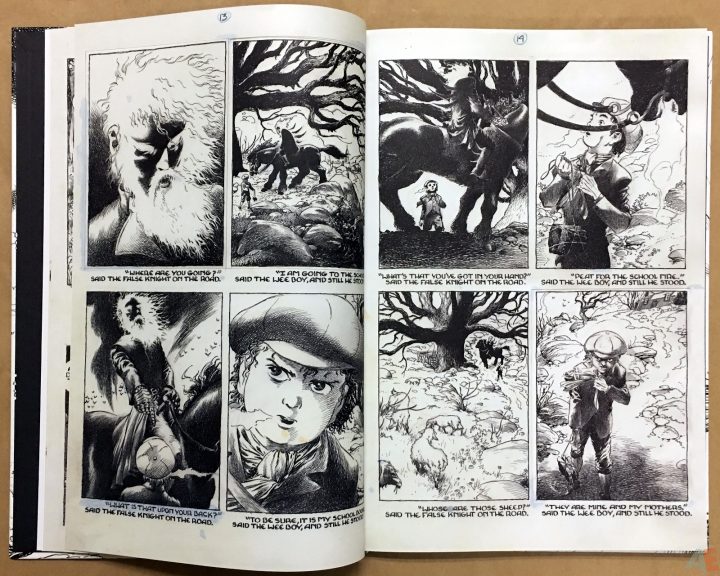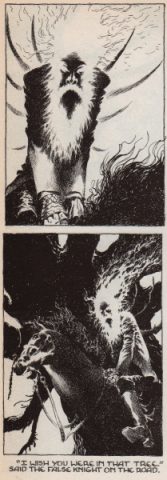The Fause Knight Upon the Road
VERSIONE A: Minstrelsy
La Tradizione orale
Maud Long
Tim Hart e Maddy Prior
Steeleye Span
Francis James Child pubblicò la ballata The Fause Knight Upon the Road al # 3 nella sua Bibbia della British Balladry (“The English and Scottish Popular Ballads,”) poi raccolta nella tradizione orale da Cecil Sharp e stampata nel “English Folk Songs from the Southern Appalachians.” (1917)
[ Roud 20 ; Child 3 ; Ballad Index C003 ; The False Knight Upon the Road at Fire Draw Near ; Wiltshire 869 ; DT FALSKNGT , FALSKNT2 ; Mudcat 4968 , 82164 ; trad.]
Già nel titolo il Fause Knight fa pensare ad un incontro fatato – l’Elfo/Diabulus, ma come antagonista, invece della solita fanciulla alle prime armi delle precedenti ballate (#1 e #2), troviamo un bambino un po’ saputello. Suggestionata dalle storie e fiabe dei bambini sperduti nel bosco, io mi immagino l’incontro con il cavaliere al limitare di una foresta, e meglio della mia immaginazione, soccorrono le immagini della storia come illustrata da Charles Vess nel “The Book of Ballads” un fumetto d’arte andato in stampa nel 1995 e successive ripubblicazioni e nuove edizioni (Le Ballate sono state raccolte in quattro antologie, inizialmente autoprodotte e poi pubblicate da vari editori: Ballads (Green Man Press, 1997), The Book of Ballads (Tor, 2004 e 2006), The Book of Ballads and Sagas (Titan Publishing, 2018).

Il cavaliere dallo sguardo di bragia apostrofa un bimbetto sospettoso e un po’ bulletto.
Alla prima domanda il bimbo non si scompone e nemmeno si volta indietro, ma fissa deciso lo sguardo del cavaliere e risponde senza paura. Poi le domande diventano richieste e il cavaliere chiede quante pecore (anime) sono per lui – “quelle che hanno la coda blu”, risponde pronto il bimbetto; e quindi il cavaliere passa alle intimidazioni: “Magari fossi su quell’albero!” – “in piedi sopra a un ramo”, ribatte il bimbo; “e il ramo si spezza” – “e tu caschi”, risponde il bimbo ritorcendo la maledizione sul cavaliere.
“Magari fossi in mare!” – “su una solida barca”, ribatte il bimbo; “e la barca affonda” – “e tu anneghi”, risponde il bimbo ritorcendo la maledizione sul cavaliere.
Le versioni in Child sono solo due: la versione A da Minstrelsy, Ancient and Modern (“L’arte dei menestrelli, antica e moderna”) 1818 di William Motherwell e la C dalla tradizione orale da Kells, contea di Dumfries and Galloway, riportata da un collaboratore del professore -essendo la B solo un frammento sempre da Minstrelsy. (cf)
VERSIONE A: Minstrelsy
I
“Where are you gang?”
quo’ the fause knight upon the road.
“I’m gang tae the school,”
quo’ the wee boy, an’ still he stood.
“What’s that upon your back?”
quo’ the fause knight upon the road.
“It’s only my school pack,”
quo’ the wee boy, an’ still he stood..
II
“Wha echt’s a’ thae sheep?”
quo’ the fause knight upon the road.
“My mither’s an’ my ain,”
quo’ the wee boy, an’ still he stood.
“How mony o’ them are mine?”
quo’ the fause knight upon the road.
“A’ them that hae blue tails,”
quo’ the wee boy, an’ still he stood..
III
“I wisht you were in yon tree,”
quo’ the fause knight upon the road.
“An’ a guid branch under me,”
quo’ the wee boy, an’ still he stood.
“An’ the branch for tae brak,”
quo’ the fause knight upon the road.
“An’ ye’s for tae fa’ doon,”
quo’ the wee boy, an’ still he stood.
IV
“I wisht you were in yon sea,”
quo’ the fause knight upon the road.
“An’ a guid boat under me,”
quo’ the wee boy, an’ still he stood.
“An’ the boat for to sink,”
quo’ the fause knight upon the road.
“An’ ye’s for to be drowned,”
quo’ the wee boy, an’ still he stood.
Traduzione italiana di Cattia Salto
I
“Dove stai andando?”
disse il falso cavaliere sulla strada
“Vado a scuola”
disse il bimbo su due piedi
“E cosa porti sulla schiena?”
disse il falso cavaliere sulla strada
“E’ soltanto la mia borsa dei libri”
disse il bimbo su due piedi
II
” Oh di chi sono tutte le pecore?”
disse il cavaliere sulla strada
“Di mia madre e mie”
disse il bimbo su due piedi
“Quante sono mie?”
disse il falso cavaliere sulla strada
“Quelle dalla coda blu”
dice il bimbo su due piedi
III
“Oh vorrei che tu fossi su quell’albero”
dice il falso cavaliere sulla strada
“Con un grosso ramo sotto di me”
dice il bimbo su due piedi
“E il ramo si romperà”
dice il falso cavaliere sulla strada
“E sicuramente cadrai”
dice il bimbo su due piedi
IV
“Oh vorrei che tu fossi in quel mare”
dice il falso cavaliere sulla strada
“E una buona barca sotto di me”
dice il bimbo su due piedi
“E la barca affonderà”
dice il falso cavaliere sulla strada
“E tu affogherai”
dice il bimbo su due piedi
La Tradizione orale
La ballata è stata trovata nella tradizione orale della Scozia, in America e in Canada. Una versione diventata “standard” viene da Tim Hart e Maddy Prior rielaborata da quella raccolta da Maud Long.
Maud Long
“Where are you going?” said the knight in the road.
“I’m going to my school,” said the child as he stood.
He stood and he stood, he well thought on, he stood,
“I’m going to my school,” said the child as he stood..
“Oh, what do you study there?”
“We learn the word of God,”
“Oh, what are you eating there?”
“I’m eating bread and cheese,”
“Oh, won’t you give me some?”
“No, nare a bite nor crumb,”
“I wish you were in the sea,”
“A good boat under me,”
“I wish you were in the sand,”
“A good staff (1) in my hand,”
“I wish you were in a well (2),”
“And you that deep in Hell,”
Traduzione italiana di Cattia Salto
“Dove vai?” disse il cavaliere sulla strada
“Vado a scuola” disse il bimbo su due piedi
su due piedi, su due piedi ci ha pensato bene, su due piedi
“Vado a scuola” disse il bimbo su due piedi
“Oh e cosa studi a scuola?”
“Studiamo la parola di Dio”
“E cosa mangerai a scuola?”
“mangerò pane e formaggio”
“Oh me ne darai un poco?”
“No, nè crosta e nè briciola ”
“Magari tu fossi nel mare”
“Con una buona barca sotto di me”
“Magari fossi sulla spiaggia”
“Con un buon bastone in mano”
“Magari fossi nel pozzo”
“E tu nel buco dell’Inferno”
NOTE
(1) bastone da passeggio, ma anche bastone del pastore
(2) in altre versioni è il suono della campana che richiama il diavolo all’inferno
Tim Hart e Maddy Prior
“Oh, what brings you here so late?”
said the knight on the road.
“I go to meet my God ,”
said the child as he stood.
And he stood and he stood,
And it’s well that he stood.
“I go to meet my God,”
said the child as he stood.
“Oh, how will you go by land?”
“With a strong staff in my hand,”
“Oh, how will you go by sea?”
“With a good boat under me,”
“Oh, me thinks I hear a bell.”
“It’s ringing you to hell,”
“Oh, what brings you here so late?”
said the knight on the road.
“I go to meet my God,”
said the child as he stood.
And he stood and he stood,
And it’s well that he stood.
“I go to meet my God,”
said the child as he stood.
“Che ti porta da queste parti, così tardi?”
disse il cavaliere sulla strada
“Vado a incontrare il mio Dio”
disse il bimbo su due piedi
su due piedi, su due piedi
ed è un bene che fosse in piedi
“Vado a incontrare il mio Dio”
disse il bimbo su due piedi
” E come andrai via terra?”
“Con un grosso bastone in mano”
” E come andrai via mare?”
“Con una buona barca sotto di me”
” Oh credo di sentire una campana”
“Ti sta chiamando all’inferno”
“Che ti porta da queste parti, così tardi?”
disse il cavaliere sulla strada
“Vado a incontrare il mio Dio”
disse il bimbo su due piedi
su due piedi, su due piedi
ed è un bene che fosse in piedi
“Vado a incontrare il mio Dio”
disse il bimbo su due piedi
Steeleye Span
1.“Oh, where are you going?”
says the false knight on the road.
“I’m going to me school,”
says the wee boy and still he stood.
“What is on your back?”
“Me bundles and me books,”
2.“I came a-walking by your door,”
“That lay in your way,”
“Flung your dog a stone,”
“I wish it was a bone,”
3.“Oh, what sheep and cattle’s that?”
“They’re mine and me father’s,”
“And how many shall be mine?”
“The ones that have the blue tail,”
4.“Oh, can I get a share o’ them?”
“You cannot get a share of them,”
“And why the stick all in your hand?”
“To keep me from all cold and harm,”
5.“Oh, I wish you were in yonder tree,”
“A ladder under me,”
“The ladder it’ll break,”
“And you will surely fall,”
6.“I wish you were in yonder sea,”
“A good boat under me,”
“The boat will surely sink,”
“And you will surely drown,”
7.“Has your mother more than you?”
“Oh, none of them for you,”
“I think I hear a bell,”
says the false knight on the road.
“It’s ringing you to hell,”
says the wee boy and still he stood.
“Dove stai andando?”
dice il falso cavaliere sulla strada
“Vado a scuola”
dice il bimbo saldo su due piedi
“Cos’hai sulla schiena?”
“Il pacco(1) dei miei libri”
“Sono passato davanti alla tua porta”
“Che si trova sulla tua strada”
“Ho tirato una pietra al tuo cane”
“Magari fosse un osso”
“Oh di chi sono le pecore e quella mandria?”
“Sono miei e di mio padre”,
“E quante diventeranno mie?”
“Quelle dalla coda blu,”
“Oh, posso prenderne una parte?”
“Non puoi prenderne una parte”,
“E perchè tieni il bastone in mano?”
“Per proteggermi dagli acciacchi e dai pericoli”,
“Oh, vorrei che tu fossi su quell’albero laggiù”,
“Una scala sotto di me”
“La scala si romperà”,
“E sicuramente cadrai”
“Vorrei che tu fossi laggiù nel mare”,
“Una buona barca sotto di me,”
“La barca sicuramente affonderà”
“E tu sicuramente annegherai”
“Ha tua madre altri oltre a te?”
“Oh, Nessuno per te”
“Mi sembra di sentire una campana”
dice il falso cavaliere sulla strada.
“Ti sta chiamando all’inferno”
dice il bimbo saldo su due piedi
NOTE
(1) nelle versioni scozzesi diventa un bannock tipico pane/focaccia/dolce scozzese
A parte la melodia, il testo è stato semplificata rispetto alla versione di Maud Long, la loro versione è ripresa dagli Oysterband e dagli Owl Service
FONTI
Testo con file audio midi http://www.contemplator.com/america/school.html
dettagliatissimo esame di varie versioni della canzone (in inglese):
http://bluegrassmessengers.com/recordings–info-fause-knight-upon-the-road.aspx
esame delle varie versioni (in inglese)
http://mainlynorfolk.info/steeleye.span/songs/falseknightontheroad.html
varie versioni testuali, anche una in finlandese
https://www.springthyme.co.uk/ballads/balladtexts/03_FalseKnight.html
testo, spartito e audio midi
https://www.8notes.com/scores/4431.asp
recensione di Charles Vess – The Book of Ballads
https://fyreflybooks.wordpress.com/2009/04/28/charles-vess-the-book-of-ballads/
immagini da Charles Vess – The Book of Ballads
https://geekdad.com/2018/02/charles-vess-brings-magic-life-book-ballads/
discussione su mudcat (in inglese)
https://mudcat.org/thread.cfm?threadid=82164

